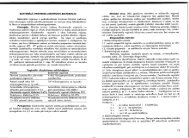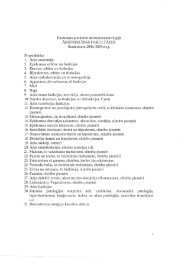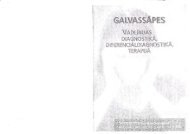PHYSICS
n - susliks.lv
n - susliks.lv
- No tags were found...
You also want an ePaper? Increase the reach of your titles
YUMPU automatically turns print PDFs into web optimized ePapers that Google loves.
of electric charge; likewise, a wire with current passing through it<br />
creates a magnetic field due to the charge moving in the wire. Bar<br />
magnets also produce a magnetic field.<br />
Let us define a magnetic field vector lJ (sometimes called the<br />
magnetic induction) at some point in space in terms of a magnetic<br />
force would be exerted on an appropriate object - a charged<br />
particle moving with a velocity V. Magnetic force (Lorenz force)<br />
acting on a particle with charge q depends on the velocity V of<br />
the charge and is equal to<br />
PM = q [V x B] (18.1)<br />
where [V x Bj is the cross product of vectors V and lJ (fig. 18.1).<br />
This force is always perpendicular to both vectors V and s.<br />
Fig. 18.1. The Lorenz force PM<br />
acting on a charged particle with<br />
charge q moving with a velocity<br />
V in the presence of a magnetic<br />
field lJ<br />
_<br />
F<br />
M<br />
F M<br />
i3<br />
_v<br />
Fig. 18.2. The Lorenz force: a <br />
the directions of the magnetic<br />
force PM' velocity V of charged<br />
particle, and magnetic field s,<br />
b - the right-hand rule for the<br />
determining the direction of the<br />
The right-hand rule for the determination the direction of the<br />
Lorenz force (fig. 18.2): you point the four fingers of your right<br />
hand along the direction of V, and then turn them until they point<br />
along the direction of lJ,. the thumb then points in the direction<br />
of PM'<br />
132<br />
a<br />
b<br />
",It<br />
;~~;<br />
(~<br />
~<br />
:J~<br />
'I,<br />
The unit of the magnetic field is the tesla (1 T = 1 N/Am).<br />
For a large magnetic field, the commonly used subunit is the<br />
gauss (I T = 10 4 G), e.g., the magnetic field of the Earth is<br />
about 0.5 G, while the magnetic field of a large electromagnet is<br />
about 1 T.<br />
Example. A proton moves with a speed of 8.10 6 rn/s along the<br />
x axis. It enters a region where there is a field of magnitude 2.5 T,<br />
directed at an angle of 60° to the x axis. Calculate the initial magnetic<br />
force and acceleration of the proton.<br />
Solution. From Equation (18.1) , we get:<br />
F = q Vbsine = (1.6.10- 19 C)(8·1 0 6 m/s)(2,5 T)(sin60o) = 2.77-10- 12 N.<br />
18.2. THE MASS SPECTROMETRY<br />
Consider the case of positively charged particle moving in a<br />
uniform external magnetic field with its initial velocity vector<br />
perpendicular to the field. Let us assume that the magnetic field<br />
is into the page. Charged particle moves in a circle whose plane is<br />
perpendicular to the magnetic field. As the force PM deflects the<br />
particle, the directions of V and PM change continuously. Therefore<br />
the force PM is a centripetal force. From Newton's second<br />
law, we find that<br />
or<br />
F = qVB = mV 2<br />
r = mV<br />
qB<br />
r<br />
(18.2)<br />
(18.3)<br />
The mass spectrometer is an instrument that separates atomic<br />
and molecular ions according to their mass-to-charge ratio. A<br />
beam of ions first passes through a velocity selector and then<br />
enters a uniform magnetic field (f3) directed into the paper<br />
(fig. 18.3). Upon entering the magnetic field, the ions move in a<br />
semicircle of radius r before striking a photograph plate at P.<br />
From Equation (18.3) we can express the ratio m/o as<br />
m<br />
·I q<br />
rB<br />
V<br />
(18.4)<br />
133






